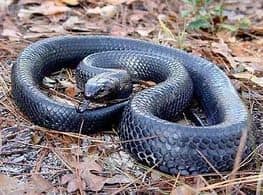

Adult Eastern Coachwhip with black head and neck and tan body exhibiting periscoping behavior. It is great for the species, but I am also really happy for Traci and the staff who have worked for years to make this happen. Eastern Coachwhip (Masticophis flagellum) Non-venomous Eastern Coachwhips typically have a black head and neck and a tan body and tail. The eastern indigo snake has uniform blue-black dorsal scales, with some specimens having a. "This is a monumental benchmark in conservation for Alabama and the southeast region for this species."Īlabama Department of Conservation and Natural Resources Commissioner Chris Blankenship also said: "I am thrilled that we have documented wild reproduction of the eastern indigo. Indigo snake - Facts, Diet, Habitat & Pictures on. "I’m not embarrassed to say that I was shaking when I held that animal," Traci Wood, the Habitat and Species Conservation coordinator with the Alabama Wildlife and Freshwater Fisheries (WFF) Division, said at the time. In January, the first wild eastern indigo snake was documented in Alabama in more than 60 years. However, these days they also survive in peninsular Florida and southeast Georgia. The eastern indigo snakes are mostly seen throughout Florida, the coastal plain of southern Georgia, extreme south Alabama, and extreme southeast Mississippi. These snakes are mostly blue-black on the entire body or may have red, reddish-orange, or cream coloration on the chin, throat or cheeks. RM AX55GY X ray image of a coiled Eastern Indigo Snake, Drymarchon corais couperi. Females are smaller reaching up to 6.5 feet and weighing around 6 pounds.

The males can reach up to 8.5 feet long and 11 pounds. Snake Lover."īlue indigos, also known as eastern indigo snakes, are not venomous and are known to eat rattlesnakes, according to the U.S. These medium-sized snakes are commonly mistaken for cottonmouths and needlessly killed. #friendlysnake #dontkillthem #sgtsnakelover." Photos of the deputy getting the snake out of the bedroom were also posted online. There are two subspecies of plain-bellied watersnake in Tennessee: the yellow-bellied watersnake and copper-bellied watersnake. It appeared to be nearly 5-foot-long, local reports said.Ī post on the Uvalde County Sheriff Office's Facebook page states, "Relocating a rattlesnake-eating blue indigo from someone's bedroom in Uvalde Estates. The reptile was found inside a home in the Uvalde Estates area of Uvalde County. It was identified as a blue indigo, the longest snake species found in North America. A large snake was found in a person's bedroom in Texas on Saturday.


 0 kommentar(er)
0 kommentar(er)
